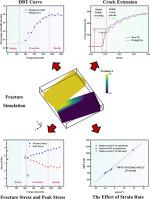Molecular dynamics study on the ductile-to-brittle transition in W-Re alloy systems
IF 8.3
1区 材料科学
Q1 MATERIALS SCIENCE, MULTIDISCIPLINARY
引用次数: 0
Abstract
Ductile-to-brittle transition (DBT) is frequently found in bcc W-based alloy systems, leading to varied fracture toughness at different temperatures. Re is recognized as an effective alloying element for enhancing the mechanical properties of W-based alloys and helium bubble is the major irradiation defect in W-based alloy systems, both of which affect the DBT phenomenon. Herein, molecular dynamics (MD) simulations are utilized to explore the role of Re and helium bubble in controlling the DBT curve in bcc W-based alloy. DBT curves are constructed with mode-I loading of diverse pre-cracked systems at 1–1800 K. In addition, fracture stress is determined based on the concept of critical strain energy release rate, which is echoed with DBT curves. Re's role in reducing fracture stress sensitivity contributes to the decrease in both the DBT temperature (DBTT) and DBT slope. The effect of helium bubbles is the opposite of the effect of Re. The underlying mechanisms are analyzed in relation to the behavior of the crack tips. In addition, the considerably high strain rate applied in MD simulations primarily accounts for the greater DBTT values observed compared to the experimental data. A logarithmic relationship with the strain rate is applied to connect the experimental data and MD results. Overall, this paper can deepen the understanding of the DBT phenomenon of W-based alloy system, improving the material's long-term performance and reliability.


W-Re合金体系韧脆转变的分子动力学研究
在bcc钨基合金体系中经常发现延脆转变(DBT),导致不同温度下的断裂韧性不同。Re被认为是提高w基合金力学性能的有效合金元素,而氦泡是w基合金体系的主要辐照缺陷,两者都会影响DBT现象。本文利用分子动力学(MD)模拟研究了Re和氦气泡对bcc w基合金DBT曲线的控制作用。在1- 1800k下,用i型加载方式构建了不同预裂体系的DBT曲线。此外,根据临界应变能释放率的概念确定断裂应力,这与DBT曲线相呼应。Re在降低裂缝应力敏感性方面的作用有助于降低DBT温度和DBT斜率。氦气泡的作用与Re的作用相反。分析了与裂纹尖端行为有关的潜在机制。此外,与实验数据相比,MD模拟中应用的相当高的应变率是观察到的更大的DBTT值的主要原因。采用应变速率的对数关系来连接实验数据和MD结果。总的来说,本文可以加深对w基合金体系DBT现象的认识,提高材料的长期性能和可靠性。
本文章由计算机程序翻译,如有差异,请以英文原文为准。
求助全文
约1分钟内获得全文
求助全文
来源期刊

Acta Materialia
工程技术-材料科学:综合
CiteScore
16.10
自引率
8.50%
发文量
801
审稿时长
53 days
期刊介绍:
Acta Materialia serves as a platform for publishing full-length, original papers and commissioned overviews that contribute to a profound understanding of the correlation between the processing, structure, and properties of inorganic materials. The journal seeks papers with high impact potential or those that significantly propel the field forward. The scope includes the atomic and molecular arrangements, chemical and electronic structures, and microstructure of materials, focusing on their mechanical or functional behavior across all length scales, including nanostructures.
 求助内容:
求助内容: 应助结果提醒方式:
应助结果提醒方式:


